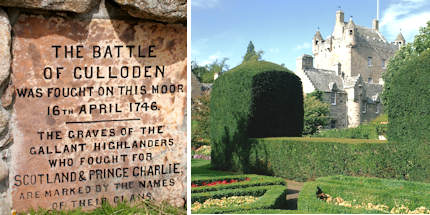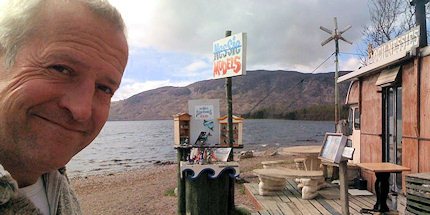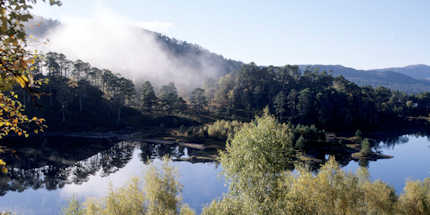Firths and fortresses: A Scottish Highlands road trip
Peppered with majestic lochs, magical castles and abundant wildlife, the Scottish Highlands provide a true insight into ‘real’ Scotland. Patrick Thorne gets behind the wheel to explore this mystical area on an all-encompassing road trip.
Inverness, the capital of the Scottish Highlands, is surrounded by a feast of historical and natural riches. To the west, rivers and winding roads meander into the spectacular scenery of the Western Highlands; to the north, the mighty Kessock Suspension Bridge opens up the Black Isle that’s bounded by shimmering firths; to the east are castles, battlefields and seaside towns; while to the south are the famous Loch Ness and popular Cairngorm National Park.
This spectacular scenery and plethora of historical sights is easily accessible by road, making the area the perfect place to explore on four wheels.
Historical Highlands
I start the day with a trip to Culloden Battlefield, a little over 8km (5 miles) to the northeast from Inverness via the B9006 road. The preserved battlefield is a great place to swot up on Highlands history, punctuated by the battle here on 16 April 1746 and its aftermath, when bans on speaking the Gallic language and wearing tartan were among the less barbaric of the punishments inflicted on the losing Highlanders.
 Learn Highlands history at Culloden Battlefield and Cawdor Castle
Learn Highlands history at Culloden Battlefield and Cawdor CastleiStockphoto / Thinkstock and Cawdor Castle
Fifteen minutes further east is the imposing Cawdor Castle, home to the Thanes of Cawdor since the 14th century. The castle itself is wonderfully preserved and still partially lived in by the family; while the walled gardens and woodland walks in its grounds provide the perfect place to lose yourself for a few hours.
Hunt for Nessie
After heading 35km (22 miles) southwest (skirting Inverness via the A96 and Dores Road), I stop for lunch in Dores, on the shores of Loch Ness. The Dores Inn has built a reputation over the past few years as a purveyor of good home-cooked, locally produced food at reasonable prices. Its prime location at the end of the mighty loch affords the perfect opportunity to be the first person to verifiably capture the elusive Loch Ness Monster on camera.
But you’ll more likely bump into Steve Feltham, who gave up a ‘normal life’ several decades ago and moved into an old mobile library van to tour the loch in search of Nessie – the van failed its roadworthiness test some years ago and is now permanently parked in The Dores Inn's car park.
 Meet Steve Feltham, the 'Nessie Hunter'
Meet Steve Feltham, the 'Nessie Hunter'Steve Feltham Nessie Hunter
After feasting on crab from Scotland's fruitful waters and venison from the surrounding hills, it’s the longest driving stint of the day, continuing southwest down the south side of Loch Ness for 39km (24 miles) to Fort Augustus – almost the entire length of the 230m-deep (755 ft) loch that holds as much fresh water as the rest of the lakes in Britain put together.
Unlike most roads in the Highlands, this former military road is relatively straight; and it grants stunning views of the loch throughout. There are plenty of places worth stopping en route, including the 43m-high (141 ft) waterfall and woodland walks at the Falls of Foyers, and Fort Augustus itself, where there’s a magnificent loch ladder along the charming Caledonian Canal.
I soon head northwest along the A82, following the north side of the loch for 31km (19 miles) to Drumnadrochit, where Urquhart Castle stands overlooking the loch on a headland – the crumbling ruins are the perfect subject for a panoramic photo with a striking backdrop. While a short distance further on, Drumnadrochit village is a tourist centre with two Loch Ness Monster exhibitions.
Creatures great and small
After Nessie overload, I head west along the A831 to Glen Affric, an area of great natural beauty, where the ancient Caledonian Forest still remains and is home to some wonderful trails. One such walk is along Dog Falls, an area rich in flora and fauna that’s home to at least 15 species of dragonflies.
 Look for wildlife along the various trails at Glen Affric
Look for wildlife along the various trails at Glen AffricThe Forestry Commission
En route to Beauly, I pass the Aigas Field Centre – where you can learn about local wildlife through guided programmes – and pursue the route hugging the banks of the River Beauly, which I’m told has some fine salmon fishing beats.
I arrive at Beauly village in time for high tea at the Corner on the Square, an award-winning delicatessen that’s been rated among the best in Britain – it’s a great place to sample and stock up on Scottish fare.
Refreshed, I head westwards 27km (17 miles) along the A832 to Chanonry Point in Fortrose, on the Black Isle. This is the best point in Britain to watch bottlenose dolphins jump from the water, as they feast on fish forced together by a tidal surge in the Moray Firth that separates Chanonry Point from Fort George. From here, the quick 21km (13-mile) route to Inverness via the A832 and A9 completes the circle back to the city.
-------------------------------------------------------------------------------------
When to go
 Experience Scottish traditions
Experience Scottish traditionsVisitScotland / ScottishViewpoint / P Tomkins
Late spring and early autumn are the best times to drive in the Highlands: the weather, albeit unpredictable, tends to be at its best before and after summer, and the roads are not clogged with coachloads of tourists. You’ll also hopefully avoid the infamous Highland midges that can be a nuisance in the warmer months
Driving tips
The 241km (150-mile) round trip is easy to do in a day with the various stops, but you may want to spend a night or two en route to give you more time at the attractions, or to fit in a round of golf or a whisky distillery tour – just go easy on drams of Scotch if you’re driving (the current limit here is 80mg per 100ml of blood).
The A9 has seen more than 100 fatal road accidents in the past decade. Average speed cameras are currently being installed on the full length of the road.
Car rental from most major companies is available from Inverness Airport and Inverness railway station.
How to get there
 Explore Inverness
Explore InvernessVisitScotland / ScottishViewpoint / P Tomkins & Hemera / Thinkstock
FlyBe has connections to Inverness Airport from Manchester, Birmingham and London Gatwick (among other destinations); while easyJet operates flights from Bristol, London Gatwick and London Luton. East Coast’s Highland Chieftan service takes eight hours from London’s Kings Cross, via Doncaster, York, Durham, Newcastle and Edinburgh. There is also Scotrail’s sleeper service from London Euston each evening, arriving 12 hours later in Inverness.
Where to stay
Although Inverness has never been short of good country house hotels, it lacked modern boutique options until recently, when the 5-star Rocpool Reserve opened. If you prefer something more traditional, Bunchrew House on the shores of Beauly Firth is beautifully located and steeped in history; or you can start your tour right next to Culloden Battlefield with a room at Culloden House Hotel.
More information:
www.visitscotland.com
www.visithighlands.com
www.trafficscotland.org
Do you have any Feedback about this page?
© 2025 Columbus Travel Media Ltd. All rights reserved. No part of this site may be reproduced without our written permission, click here for information on Columbus Content Solutions.









 You know where
You know where